A PIPELINE RUNS THROUGH IT
FOSSIL FUEL INFRASTRUCTURE GETS A FOOTHOLD IN THE VALLEY
Story by Jon Bowermaster
Film by Chris Rahm & Devin Pickering
wo different pipelines, two different stories. One carries natural gas, the other crude oil. One goes under the Hudson River and skirts a troubled nuclear power plant, the other hoping to parallel the New York State Thruway’s ‘right-of-way,’ essentially butting up against resident’s backyards.
There are countless unknowns about the safety and future of both projects but one thing is certain…neither helps to provide New Yorkers with gas or oil.
As we’ve come to learn in our reporting of this series about risks to the Hudson River and Valley, both pipeline projects bring with them exorbitant risks and deliver absolutely no benefits.
Lengths of natural gas pipeline await burial beneath a neighborhood in Buchanan, NY.
AIM PIPELINE
Let’s take the Algonquin Incremental Market Project (AIM) first, located on the east side of the Hudson River, cutting through the heart of Westchester County. The AIM pipeline, owned by Texas-based Spectra Energy, is one of three connected construction projects linking a single series of pipelines running mostly underground from New York to Boston, carrying natural gas fracked from the Marcellus Shale in Pennsylvania. Each of the three segments has been approved by FERC – the Federal Energy Regulatory Commission – yet no agency has stepped back and taken an environmental assessment of the entire four-state project.
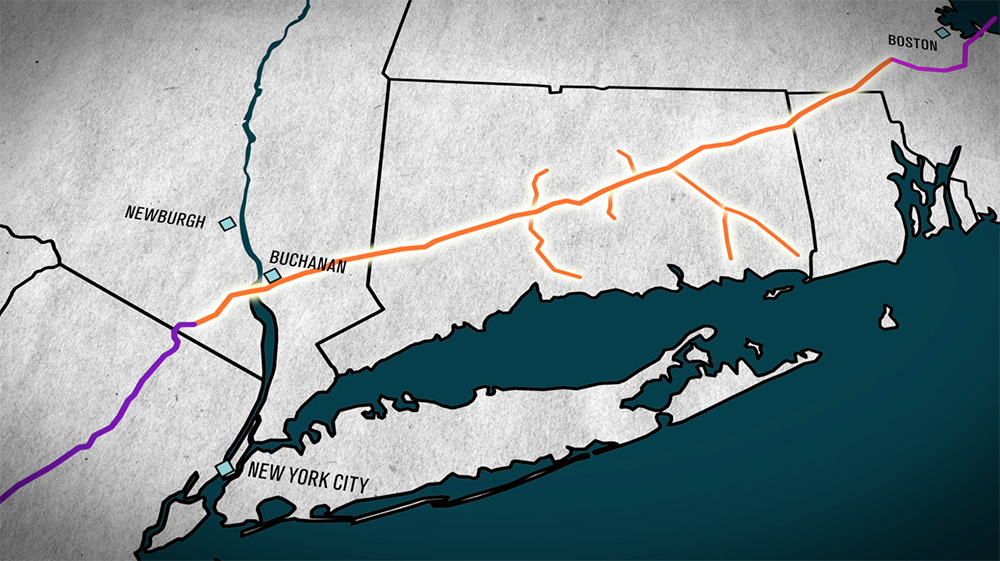
One thing to understand off the top is that AIM is not a new pipeline, but an expansion project. There is already a 26-inch-pipe buried underground running from New York to Boston crossing under the Hudson; this new construction, which has been going on for more than a year with the approval of FERC and is almost complete, is adding an additional 42-inch, high-pressure pipeline side-by-side to the older, smaller version. Why? The bigger the pipe, the more gas that can be shipped.
Like any natural gas pipeline this one runs the risk of leaking or exploding. What makes the AIM project exponentially risky is that it will run just one hundred feet from critical safety infrastructure at the Indian Point Nuclear Energy Center. If the pipe carrying violate gas were to explode near the nuclear plant it could cause a full scale meltdown reaching a radius of 50 miles and impacting the lives of more than 20 million New York, New Jersey and Connecticut residents.
How often do pipelines explode? More often than you think, thanks to the boom in fracked gas that currently needs to be transported cross country. In 2010, a natural gas pipeline blew up in a residential neighborhood next to Los Angeles International Airport, killing eight. According to an oversight group that monitors pipeline safety, Spectra and 14 pipeline operators that share some of the company’s safety program management plans have reported 31 major incidents, including large explosions and leaks between 2006 and 2014. In June 2015, a Spectra pipeline exploded underneath the Arkansas Riverreleasing 3.9 million cubic feet of gas. Despite the toxic spill, the company waited two days to inform the city’s mayor.
A sizable movement of advocates against the expanded pipeline have coalesced under the name Stop the Aim Pipeline Expansion.
THE LONG SHADOW OF INDIAN POINT
The Indian Point Energy Center in Buchanan, NY, sits just thirty miles from Times Square. One of its three aging reactors has been offline since 1974; the two others are in need of updating. A timeline shows a long history of leaks, small spills and fires going back to its opening in 1962. Many, including Governor Andrew Cuomo, would like to see the plant shut down permanently, a decision that could be made later this year. Its owner, Entergy, wants existing licenses for the two reactors extended for another twenty years.
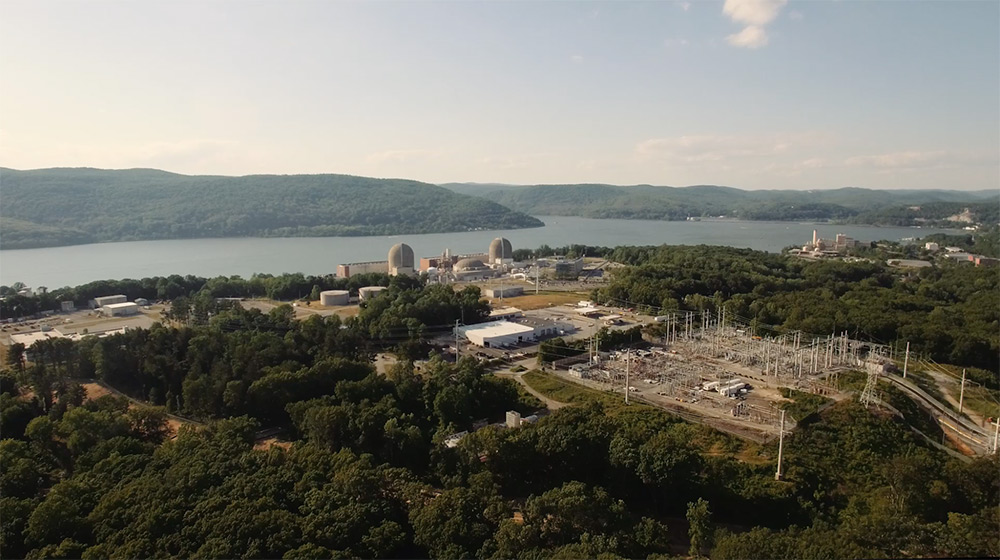
They, along with advocates for promoting clean energy sources over new pipelines, have been astonished by the ease of which the project was approved and advanced. FERC, as well as the Nuclear Regulatory Commission, both approved it based on what was clearly a scanty plan hatched on the back of a cocktail napkin. In Spectra’s primary testimony regarding the project’s safety it contended that in cases of emergency it would be able, from HQ in Texas, to shut off the flow of gas in the pipeline within three minutes. Even former Spectra inspectors cast high doubt on the feasibility of such a remote, long-distance shutdown. Both U.S. Senators from New York, Charles Schumer and Kirsten Gillibrand, as well as a list of Congresspersons and all of the leading environmental groups have questioned the wisdom and necessity of the project and attempted to bring it to the attention of federal regulators.
Only to be ignored.
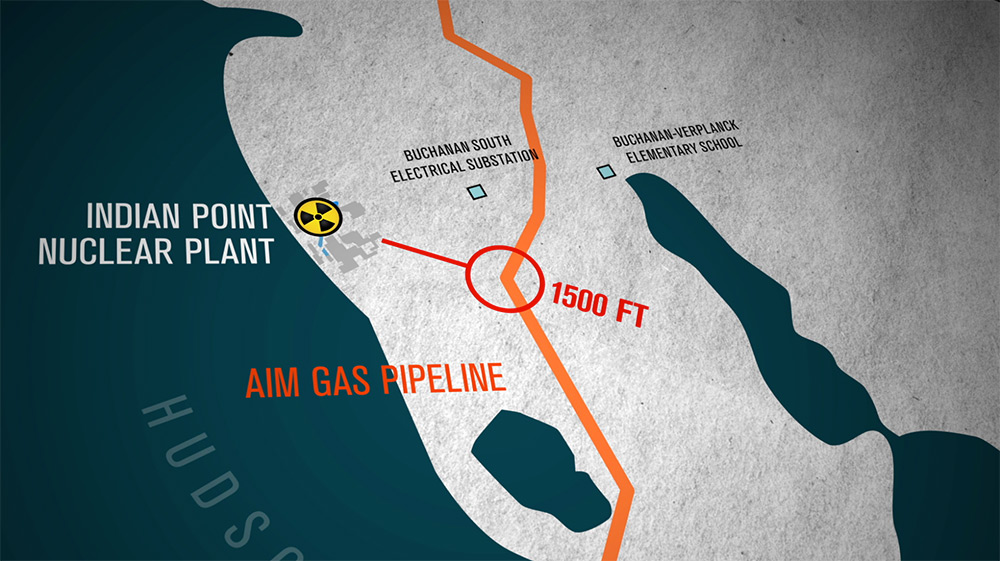
According to one of the project’s nearest neighbors and most articulate protestors, molecular biologist Courtney Williams, who grew up in the shadow of Indian Point, a natural gas explosion adjacent to Indian Point could result in a Fukushima-like meltdown and require the evacuation of New York City, 35 miles away.
“With (the pipeline) four-hundred-feet from my front door and four-hundred-feet from my kids elementary school, worrying about the worst case scenario is something I do on a routine basis,”
– Courtney Williams

We walked with Courtney and her family to the end of their block, turned left and in 200 feet stood at a giant clear-cut scar coursing downhill through the pine forest. Swivel to the right and the pipes cut under 9W and then skirt the nuclear power plant.
“With (the pipeline) four-hundred-feet from my front door and four-hundred-feet from my kids elementary school, worrying about the worst case scenario is something I do on a routine basis,” Williams told a reporter.
The New York Thruway in Ulster County. The Pilgrim Oil Pipelines are intended to be constructed inside the Thruway right of way for 79% of its 170 mile stretch.
PILGRIM PIPELINES
Directly across the river, on the west side, a proposed 180-mile-long pipeline to be built from scratch has got locals expressing disbelief and concern. The project is called the Pilgrim Pipeline, named for its parent company, a Connecticut-based start-up known as Pilgrim Pipeline Holdings.
Twin pipelines would slice through the Catskills carrying crude oil originating in the shale fields of North Dakota. The oil would travel south from Albany and then return refined gasoline north from New Jersey refineries.
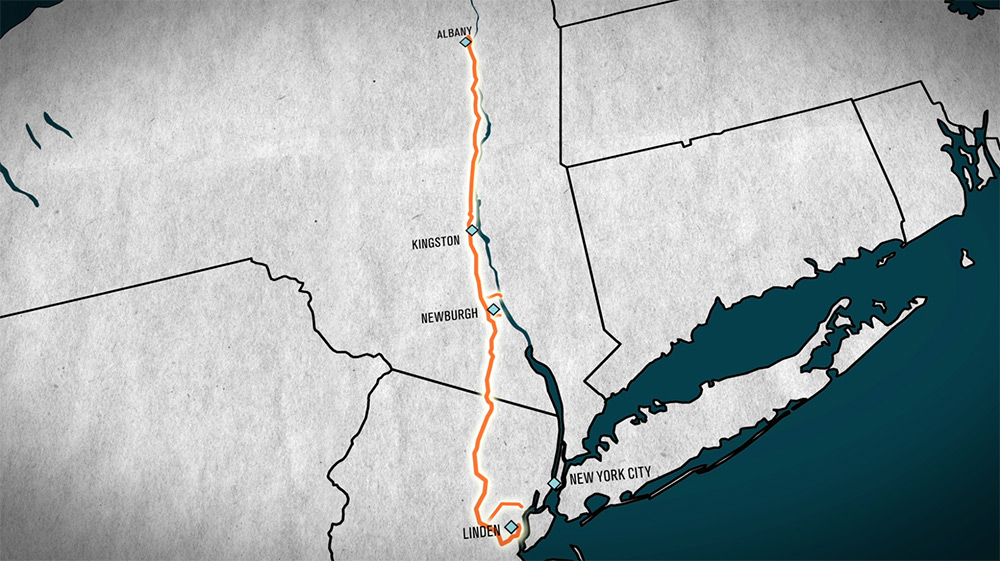
The pipes would cut across five counties and thirty towns in New Jersey and six counties and twenty five towns. It would cut across major rivers and creeks including the Wallkill, Catskill, Rondout, Esopus and Moodna and more than 232 regulated streams, wetlands, and protected areas. At every mile post a service road would be cut in to the pipelines to provide access; part of the construction’s promise is that none of the traffic necessary to build the project would use the Thruway, thus turning small local roads into busy thoroughfares during construction. The ultimate goal would be to pump nearly 17 million gallons of oil each day between the two states.
Leading the effort to stop the twin pipelines is the Coalition Against Pilgrim Pipeline (CAPP).
Unlike natural gas pipelines, which are regulated by the federal government, new oil pipelines are approved almost exclusively by state governments, even when crossing state lines. Governors Christie and Cuomo have so far been silent on the Pilgrim project.
What amazes me most about the project was that the dozens of communities the pipeline would cut through were informed about it only when workers started knocking on doors in New Paltz and asking residents about land rights and access. What’s truly astonishing is that the pipeline company did not have to first go to the State of New York for it’s opinion on the project; instead it began surreptitiously trying to piece together land and access to private properties it would inevitably have to secure if the project were to go forward.
It’s funny, that’s not how my town zoning laws work here in Ulster County. If I want to build a toolshed near my neighbor’s border, I need to first go to the town’s zoning board for approval. Then, after several months of hearing, maybe I can proceed. In this instance, while the pipeline builders were saying they would build the pipe on the New York State Thruway’s ‘right of way,’ they were not-so-quietly going around and trying to buy access to the other lands they’d need to complete the project.
Turns out they had applied for construction permits in the summer of 2015 from the Thruway Authority, without any public disclosure. No notices, no meetings, no hearings, no debate.
That backdoor attempt of course backfired. It instigated a huge debate over which state agency would oversee the project’s application and construction. Pilgrim requested its overseer to be the Thruway Authority, the same agency that would be receiving “rent” for the land use. Advocates insisted the state’s Department of Environmental Conservation be the chief, judge and jury. Ultimately, it was decided both would share the oversight.
The amount of oil spilled from pipelines is far greater than all other methods of oil transport combined.
Pipeline proponents like to argue that they are “safer” than barges or bomb trains for delivering crude oil. But that’s a false argument. All pipelines leak, all the time, so the mere existence of them creates pollution. In fact the amount of oil spilled from pipelines is far greater than all other methods of oil transport combined. This proposed project would not replace the need for oil to be shipped through the Hudson Valley by barge or train, it would just add yet another risky delivery system to the mix.
Despite fast-spreading local opposition to the Pilgrim project — 30 Hudson Valley towns have already announced their dissent— it still advances on the drawing boards in Connecticut.
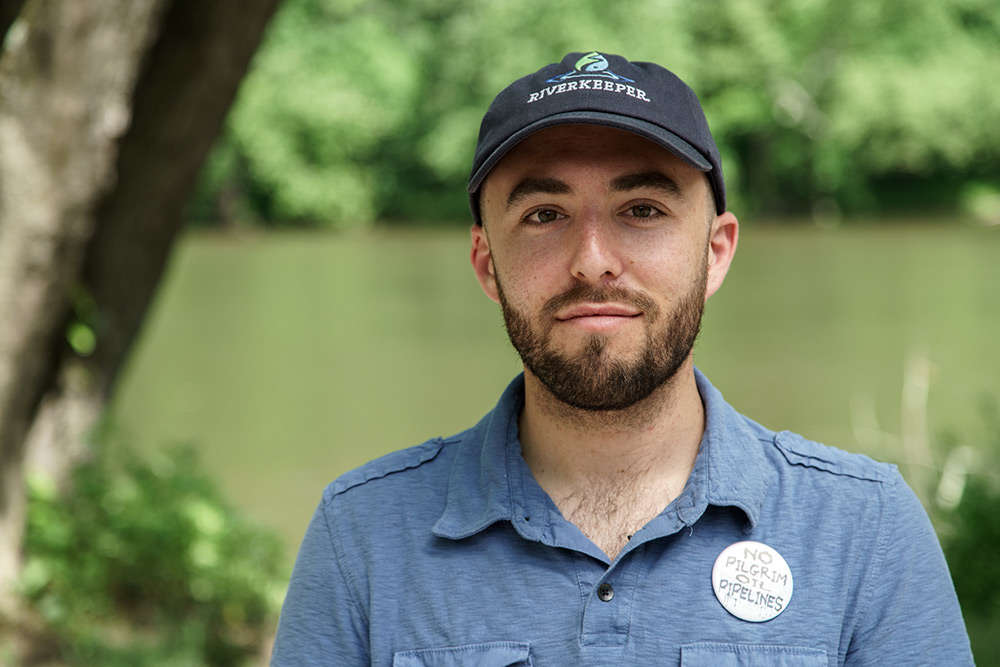
Jeremy Cherson, Campaign Advocacy Coordinator for Riverkeeper, is one of the leading opponents. He points out that seven of the nine biggest cities in its path, including Albany and Rensselaer, have passed resolutions opposing the project.
“I have confidence it is not going to happen,” says Cherson emphatically, hopefully not wishful thinking.
TAKE ACTION ON THE PILGRIM PIPELINES:
Individuals, Municipal Boards and County legislatures should write to the Governor, NYS Thruway Authority and NYS Department of Transportation and urge them to deny Pilgrim the ability to use the Thruway right of way for their pipelines.
Individuals, communities, involved and interested agencies should actively engage in the critical DEC and Thruway Authority’s environmental review of Pilgrim pipelines, which will be the record on which all subsequent permitting decisions must be made, by submitting written and oral comments on the project’s potential impacts of greatest concern to them.
TAKE ACTION ON THE AIM PIPELINE
Stand with millions of New Yorkers by speaking out publicly and to President Obama for emergency action to halt construction of the dangerous AIM pipeline now. Demand the Federal Energy Regulatory Commission (FERC) rescind its approval of the AIM pipeline project and stop construction immediately.
CALL YOUR ELECTED OFFICIALS:
U.S. SENATOR CHUCK SCHUMER: 212.486.4430
U.S. SENATOR KIRSTEN GILLIBRAND: 212.688.6262
U.S. CONGRESSWOMAN NITA LOWEY: 914.428.1707
U.S. CONGRESSMAN ELIOT ENGEL: 718.796.9700
U.S. CONGRESSMAN SEAN MALONEY: 845.561.1259
GOVERNOR ANDREW CUOMO: 518.474.8390



